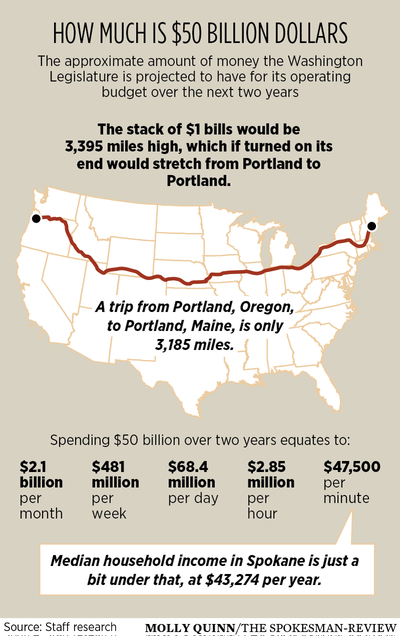State operating budget will hit $50 billion for 2019-21, but will it be enough?

Fifty billion dollars. It’s an amount that rolls easily off the tongue, even though it’s hard to imagine.
Fifty billion bucks. Fifty billion simoleons. Fifty billion smackers.
That’s the approximate amount of money the Washington Legislature is projected to have for its operating budget over the next two years to cover the majority of its policies, programs and personnel expenses.
If, as Puff Daddy once said, it’s all about the Benjamins, that would be about five hundred million Benjamins. Or a billion Grants. Or 2.5 billion Jacksons, if you prefer smaller bills.
You wouldn’t want it in ones. The stack would be 3,395 miles high, and you’d need an oxygen mask to grab a few bucks off the top to pay for that latte and tip the barista. If you laid them end to end, $50 billion in ones could stretch around the world almost 82 times.
The state doesn’t actually get most of its tax money in bills, but in checks and electronic transfers. And it doesn’t all come in at once, so there aren’t huge stacks of money in a safe at the Capitol.
But $50 billion is a lot to spend. It’s almost $2.1 billion per month for the two-year budget cycle. Or $481 million per week; $68.4 million per day; $2.85 million per hour; $47,500 per minute.
Finally, a number we can relate to, considering the median household income in Spokane is just a bit under that, at $43,274. Of course, that’s for a year.
It’s slightly more than a third of Jeff Bezos’s listed net worth of $131 billion, although that amount goes up and down with stock prices and is about to be cut in half by his divorce. It’s slightly more than half the listed net worth of Bill and Melinda Gates.
The amount is roughly the gross domestic product of Uzbekistan.
It could buy 116 baseball players of the caliber of Mike Trout – who signed a 12-year contract for $430 million this past week – if that many were available. Or 97 Safeco/T-Mobile fields, to give them places to play.
It could pay for almost four nuclear powered aircraft carriers. Or 562 F-35 fighter jets.
It’s about eight times as much money as President Donald Trump wanted for his border wall, which Congress declined to give him and he’s taking from other sources through an emergency declaration.
While these examples help illustrate that $50 billion is a very large sum of money, it’s not really possible to compare what a government spends to what an person spends. Above a certain level of income, a person’s spending is mostly discretionary – a new Mercedes instead of a used Chevy; a lake cabin instead of a tent and sleeping bags. For the state government, much of its money is obligated long before it comes in on programs that can increase in cost when more people need them.
About half of that $50 billion is obligated to public schools, which serve roughly 1 million students. The amount going to schools is up, because the state finally made enough improvements to satisfy the Supreme Court that it was meeting its constitutional mandate to provide for basic education. It’s expected to pay even more next year because most people agree the schools need more help on things like special education.
Some of it goes to pay a portion of the cost of educating students who graduate from public schools and go on to state colleges and universities, because tuition only pays for part of that.
The state also has nearly 64,709 employees who get paychecks, plus health care and other benefits. Those state workers help protect children and families, make sure workers are safe, help businesses sell their products, collect taxes, monitor various professions and watch for pollution. Some also patrol and maintain the roads and highways, although technically most of that money comes out of another pot.
The state operates mental hospitals and prisons. It owns and manages forests, range land and tidelands. It provides health insurance to some people who can’t afford it, financial assistance to others. It socks away a portion of what comes in for a rainy day. (One reserve account is actually called the Rainy Day Fund.)
That $50 billion, which is about what economists project will be collected for the general fund through taxes and fees over the next two years, would constitute a record for a biennial operating budget in Washington. It’s about $5 billion more than the current two-year budget.
But when House Democrats release their budget proposal Monday, the debate will be whether it’s enough to cover everything the state needs to do in the next two years. Democrats will say $50 billion barely covers current programs, promised increases and inflation. The state needs to do more on mental health, homelessness and drug addiction, cleaning up the environment and providing even more help to schools and students who can’t afford college, they’ll say.
To do all those things, they’re expected to propose new taxes, or changes to the current system.
Republicans will say the extra $5 billion is enough for current and new programs, and maybe so much that taxes should be cut.
That will put $50 billion at the center of the key debate for the next month in the Legislature.